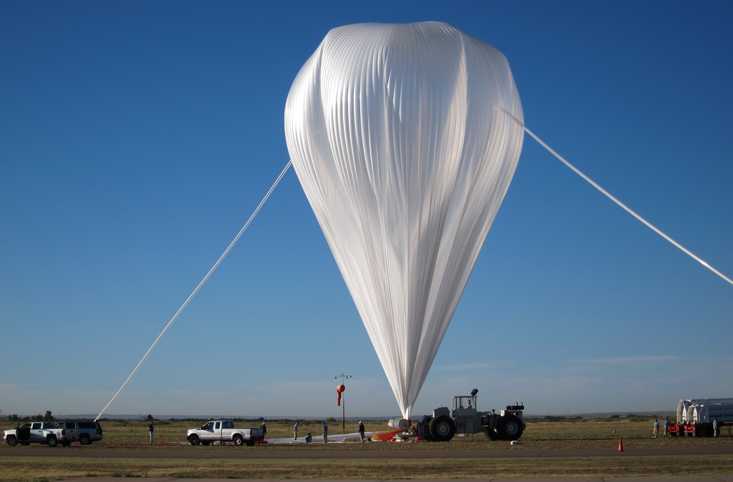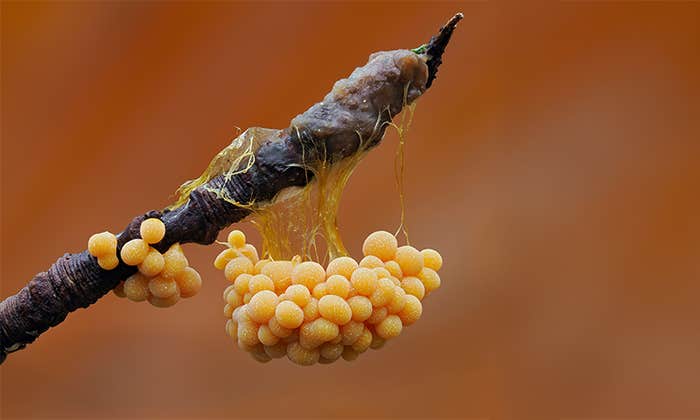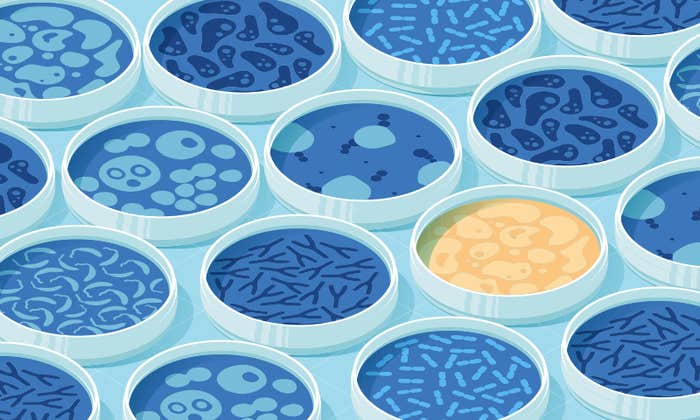Rippling like a jellyfish, a helium balloon big enough to envelop the Empire State Building lofted over the New Mexico desert. Its passengers, suspended below in a boxy white gondola, were hardy specimens: millions of cells of a remarkably resilient bacterium known as Bacillus pumilus SAFR-032. NASA scientists had first collected the strain more than a decade ago in the Mars Odyssey assembly facility, where the bacteria had survived sterilization. Before sending the pill-shaped cells into the sky last October, researchers starved them until they morphed into endospores, an armored dormant state.
Higher and higher the wee wayfarers rose: to 17,000 feet, the maximum altitude at which trees grow; to 24,000 feet, the upper limit of the highest-flying migratory bird, the bar-headed goose; to 60,000 feet, where atmospheric pressure is so low that water in bodily tissues would boil away. At last, at 100,000 feet, the balloon reached its destination. Here in the stratosphere, above the troposphere and most of Earth’s protective ozone layer, conditions are extreme: cold as an Antarctic winter, drier than the driest desert, and flooded in ultraviolet rays. “Mostly, it’s eventual death,” says Cindy Morris, a microbial ecologist at the French National Institute for Agriculture Research.

Yet scientists are finding that a rich variety of life—archaea, bacteria, and single-celled eukaryotes—can thrive at high altitudes. In the troposphere, where day-to-day weather happens, each cubic meter of cloud contains on average tens of thousands of microbial cells. Even above the clouds in near space—as high as 250,000 feet, according to a 1978 Soviet study—rocket and balloon missions have collected hearty voyagers. “We’re not just finding corpses that are blown up there and preserved,” says Brent Christner, a microbiologist at the University of Florida. “Some fraction of these organisms is still alive.”
Lacking wings or pressure suits, these Lilliputian aeronauts have devised ways to protect themselves from irradiation, desiccation, and severe cellular stress, and find food in the bleakest of food deserts. Their unique set of survival skills has allowed them to soar the skies, dispersing to some of the harshest environments on Earth. And perhaps beyond: If B. pumilus cells can live through a balloon ride to the stratosphere, what’s stopping them from hitching a lift to Mars? “If organisms are blowing around in the stratosphere, and we took them and we put them on the Mars surface,” Christner says, “they wouldn’t even know the difference.”
Of course, microbes don’t need balloons to fly. Some fungal spores catapult from cannon-like structures in their parent. Wind or sea spray can similarly launch cells into the air. But most simply levitate, Mary Poppins style, in a passing updraft. “There’s always upward movement of air because the Earth is always heating the atmosphere,” Morris says. “It’s impossible for a particle that small to not get incorporated in these currents.”
Once airborne, the tiny drifters ride a complex and ever-shifting network of “highways in the sky,” says David Schmale, an aerobiologist at Virginia Tech. With engineer Shane Ross, he is developing ways to predict these turbulent routes. By pairing fluid dynamics modeling with data from air-sampling drones, the team has identified atmospheric features as large as countries, called Lagrangian coherent structures (LCSs), that behave “like waves moving through the atmosphere,” Schmale says. As an LCS moves over the landscape, it morphs much like an ocean swell, shuffling microbes along various air masses, like plankton along eddies.
What would happen if hardy microbes stowed away in a dark crevice on a lander?
Depending on their size and aerodynamics, microbes can stay aloft in the atmosphere for days to weeks—long enough to jump a continent, or an ocean, in one go. Analyses of meteorological data, for instance, suggest that transatlantic winds carried fungal spores from West Africa to the Americas, spreading sugarcane and coffee leaf rusts to New World plantations in the 1970s. Bacteria kicked up by dust storms in Africa’s drought-plagued Sahel appear to be making a similar leap to the Caribbean, where they are killing coral reefs. And in China, at the start of every growing season, spores causing wheat yellow rust migrate hundreds to thousands of miles from plants in the western provinces of Sichuan and Gansu to recolonize the country’s main wheat belt farther north.
Most of this globetrotting happens in the troposphere because the air there rarely mixes with air in the stratosphere above. But there are ways to catch a lift to loftier locales, including transport via thunderstorms, volcanic eruptions, and deep tropical convection. Microbes that make it to the stratosphere get swept along in its steady horizontal currents, allowing them to sail swiftly over vast distances, Christner says. “It’s a ticket to anywhere on the planet.”

No known organism can survive high altitudes indefinitely. Scientists estimate that even the fittest microbes probably last no longer than a week in the stratosphere, and around a couple of weeks in the troposphere. Eventually they “get fried by radiation,” says David J. Smith, a NASA microbiologist who led the October balloon mission testing the stamina of B. pumilus cells. As a result, some high-flying species may have evolved a method to get down fast: hijacking the weather.
Microbial matter typically falls from the sky in rain or snow. To precipitate, clouds must grow ice crystals big enough to outweigh air, but pure water vapor won’t normally freeze above -36 degrees Fahrenheit—unless it gets help from an “ice nucleator.” Most often, airborne particles such as salts or mineral dust provide this service. By supplying a seed around which water molecules can arrange themselves, a nucleator enables ice to form at temperatures up to 5 degrees. Some microorganisms produce proteins that catalyze the process in even warmer conditions, up to 28 degrees in a laboratory. Scientists have yet to prove this happens in real clouds. But if it does, it’s a handy trick: Not only have these microbes found a way to encase themselves in an icy escape capsule, but they may be able to make it drop from the sky when it otherwise wouldn’t.
According to one model, possessing these icemaking powers could help shorten a microbe’s time in the sky to about a twentieth of what it would be if it couldn’t nucleate ice at all. “The ones that are not ice-nucleation active have a little more trouble getting out,” Morris says. From a microbe’s perspective, she explains, the atmosphere is like a subway system. “There are people there all the time, but the metro is not a place to live—it’s a place to move.”
If Earth’s atmosphere is a microbial metro, it’s an especially brutal one, and commuters have evolved various means to survive the trip. Some, like the B. pumilus cells in the NASA balloon, form endospores. “Sporulation is like hibernation for bacteria,” Smith says. “They shrivel down, dehydrate all of their innards, and wrap their DNA. They remain in that state until water and nutrients arrive, and then they flip the switch and germinate, and go on living.”
Other longest-distance travelers sequester themselves in protective dust plumes. Researchers have collected deposits of African dust from all over the world, and “they’re just loaded with microbes,” Schmale says. Shade from dust can cut UV radiation by half. And as the plumes cross water bodies, they pick up particulates such as pieces of algae or phytoplankton, which “can provide wetting, moist environments for microbial populations to sustain viability as they trek across the ocean.”
Microbes can also make a temporary home in clouds. Atop the 5,000-foot peak of Puy de Dôme, in central France, microbial ecologist Pierre Amato sucks up cloud water with a droplet impactor—“a vacuum cleaner, basically,” he says. He then takes the samples back to his lab at the National Center for Scientific Research, in Aubière, where he extracts living bacteria and cultures them in flasks. Some specimens can subsist on formaldehyde and other organic compounds commonly found in cloud water, suggesting they can metabolize, and perhaps even reproduce, in clouds. “They eat some very strange things,” he says.
The most successful cloud-squatters, Amato has found, are bacteria that spend their terrestrial lives on plants—no surprise, he says, considering that these species are well-adapted to life on the surface of a leaf, where light, temperature, and humidity change rapidly, as they do in a cloud. Many of these organisms have also evolved protections against UV radiation: pigments that act as sunscreens, for instance, or the ability to rapidly repair their own DNA.
Where these widespread adaptations first arose is an open question. Did microbes hone their survival skills on the ground and then use them to take to the skies? Or vice versa? Smith, for one, argues that the arduous conditions of the upper atmosphere likely provided a selective pressure that drove terrestrial life to be as robust as it is. “Think about trillions upon trillions of tiny cells continuously passing through the Earth’s deadly upper atmosphere for billions of years,” he says. “In that framework, evolved resistance to environmental extremes seems almost inevitable.”
Take Antarctica’s ice sheets. Some of the most hostile places on Earth, they were once thought to be devoid of life. Yet in the past decade, scientists have discovered microbial species living on and in the ice, and in lakes buried below. “These microbes might not be growing actively—they might just be frozen in suspended animation—but as the climate changes and as these places melt, and as surface water starts to form, you may well see them metabolizing and reproducing,” says David Pearce, a microbiologist at Northumbria University in the United Kingdom who is part of an international collaboration to survey microbial diversity over Antarctica. Many ice dwellers, Pearce suspects, probably arrived on the winds: When he and his colleagues analyzed microbial DNA from air samples over a remote research station, they found that almost half of the airborne explorers not associated with human activity had likely originated from soils and other terrestrial sources on other continents. (Incredibly, some of these strains have also been found in spacecraft assembly rooms.)
“The upper atmosphere acts like a pre-selection filter,” Pearce says—it ensures that only the hardiest individuals disperse to colonize Earth’s remotest and most barren outposts.

The same might be said for other worlds. If the rigors of air travel can prepare microbes to thrive in Antarctica, why not the atmosphere of Venus, where relatively mild temperatures and pressures may be able to sustain Earthly life? Or the surface of Mars, where conditions aren’t so different from Earth’s upper atmosphere? If microbes like B. pumilus can survive the stratosphere, Smith says, they may be able to persevere long enough on the Martian surface to establish themselves in a more hospitable spot, such as underground, “where it might be warmer and wetter.” His team is still analyzing results from the balloon mission, but he says they seem “consistent” with what’s already known about these super-survivors, which have endured stratospheric simulation chambers and once lived for 18 months outside the International Space Station while shaded from UV light.
How Earth life might get to other planets is a matter of much debate. Airborne cells can’t reach escape velocities great enough to break free of Earth’s gravitational pull. Nor have scientists come up with a convincing explanation of how they would survive the long transport times and lethal radiation levels in deep space. But that hasn’t stopped astrobiologists from musing about panspermia, the hypothesis that life spreads throughout the universe via meteors and other cosmic vehicles—like, say, spacecraft.
For NASA, this is a very real, and troubling, possibility. The agency has identified hundreds of bacterial strains like B. pumilus that have outlived spacecraft sterilization procedures such as peroxide baths, heat shock, and UV radiation. What would happen if these or other hardy microbes stowed away in a dark crevice on a lander, or latched on as it passed through Earth’s atmosphere?
“These organisms are really very robust,” Morris says, “and they are going places.” All they need is a lift.
Chelsea Wald is a science writer in Vienna, Austria, who writes often for Nautilus.























